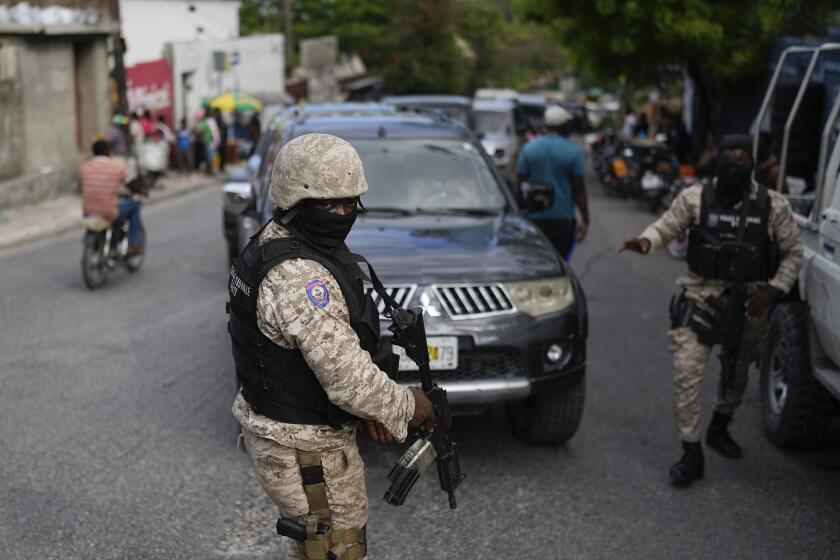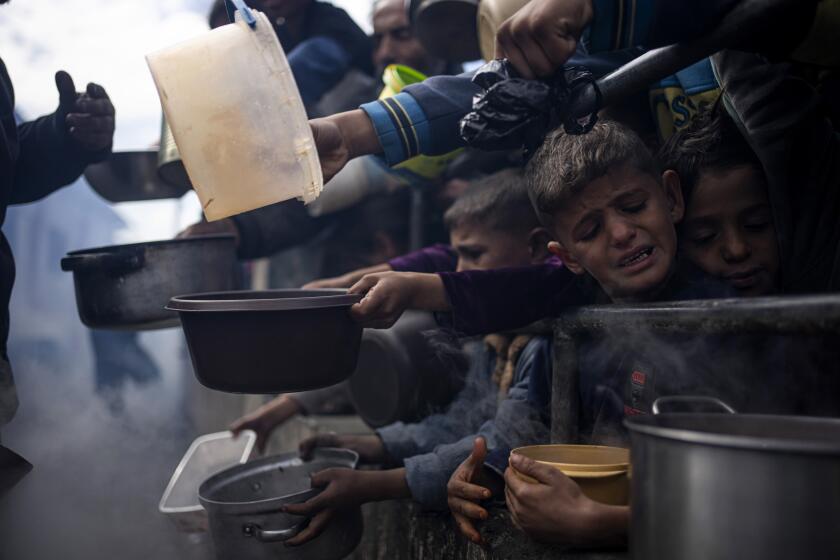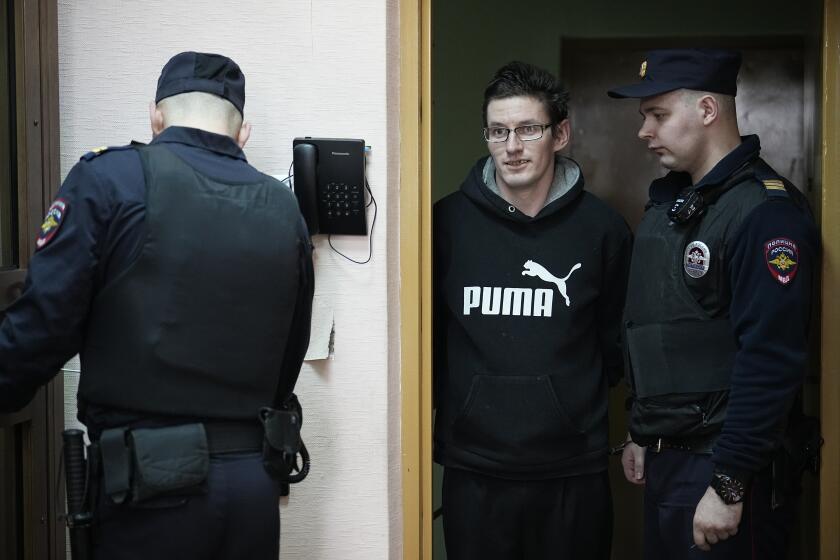Nuclear Site Stood Unguarded for Days
Three Iraqi warehouses filled with 2,500 barrels of uranium that could be enriched for nuclear weapons -- plus radioactive isotopes that could be used for deadly “dirty bombs” -- lay unguarded for several days this week as Iraqi mobs swirled around.
The facility, known as Location C, was Iraq’s only internationally sanctioned storage site for nuclear material. It thus was a potential prize for U.S. forces -- or for anyone seeking to steal radioactive material for sale to other countries or to terrorists.
Iraqi Republican Guard troops abandoned the site late last week as U.S. armored columns approached the nearby Tuwaitha nuclear research center south of Baghdad. Hordes of looters soon cut Tuwaitha’s electric fences and began ransacking homes and offices in the complex, hauling off TVs and carpets in stolen luxury cars.
U.S. officials said Marine combat engineers secured Location C on Wednesday after a State Department counter-terrorism task force warned Central Command of the danger.
Experts, though, say the lapse points to a larger concern: the immediate need to find and secure Iraq’s nuclear weapons components, ballistic missile manuals, precursor chemicals for nerve gases, microbe feeder stocks for germ weapons, and countless other potentially dangerous materials that could aid terrorists or illegal weapons programs around the world.
“There’s a tremendous danger now that materials could slip out of the country,” warned Rolf Ekeus, who headed United Nations weapons teams in Iraq during most of the 1990s. “It’s very important that these sites be taken under control immediately.”
Although Iraq has not used weapons of mass destruction so far, the Bush administration believes that the country has the capability.
It wasn’t clear Thursday whether special U.S. weapons teams had reached Location C. Officials at the Pentagon and in Qatar said they did not know whether anyone had breached the steel doors and removed any of the 500 tons of unrefined uranium and uranium dioxide and the 150 transportable devices with radioactive isotopes from Iraqi hospitals and research facilities that were stored at the site.
“The most immediate concern is the radioactive isotopes,” said David Albright, a former nuclear weapons inspector in Iraq who now heads the nonprofit Institute for Science and International Security in Washington. “You worry that some idiot will take them and spread them around.... Or that someone will try to sell them for a dirty bomb,” which uses conventional explosives to disperse radioactive materials.
Another potential problem is the 3,000 or so Iraqi scientists, military officers and engineers who provided the intellectual heft, technical expertise and command structure for Hussein’s clandestine weapons production and procurement systems, according to U.N. records. About 100 are considered crucial to shedding light on Iraq’s secret programs. None has yet been interrogated.
Indeed, not all their identities are known. Experts warn that Iraq’s weapons designers may flee and offer their services to other regimes before they can be rounded up. Most of the scientists and engineers at Tuwaitha, for example, disappeared before U.S. troops arrived.
“There could be a brain drain like we saw after the collapse of the Soviet Union,” said Jonathan Tucker, a former U.N. inspector now at the U.S. Institute for Peace in Washington.
“These are people with valuable technical know-how. Presumably they’re now unemployed. They might be tempted to work for other countries or for Al Qaeda.”
The Pentagon and CIA are offering large cash rewards in hopes that some of Iraq’s scientists, freed from fear of Hussein’s regime, will come forward to lead U.S. investigators to the dictator’s suspected secret weapons and document stashes.
“You’re not going to find the weapons unless you talk to the people who know where they are,” said Richard O. Spertzel, a former U.N. biological weapons team leader. “Iraq’s method of hiding weapons was to dig a hole in the sand, put the weapon in, put a tarp over it and put the sand back.”
Those Iraqi scientists or officials who don’t agree to talk may face war crimes charges or prison, U.S. officials said. Either way, the hunt could last years.
So far, U.S. forces have found none of the illegal weapons that Bush administration officials allege are hidden in Iraq -- and that still could be used as battlefield or terrorist weapons. President Bush and British Prime Minister Tony Blair repeatedly cited the presumed existence of forbidden weapons as the chief justification for invading Iraq.
The White House repeated the charge Thursday. “We have high confidence that they have weapons of mass destruction,” Press Secretary Ari Fleischer said. “This is what this war was about and is about. And we have high confidence it will be found.”
Jessica Tuchman Matthews, president of the Carnegie Endowment for International Peace, said Washington should allow U.N. weapons inspectors back into Iraq to assist in the search and to provide an independent assessment of any weapons found. The U.N. teams have amassed vast databases that are unavailable to the U.S. teams.
“There’s no question it would be helpful both for international legitimacy and for simple expertise,” Matthews said.
Fleischer said the Bush administration “never ruled out the possibility of U.N. inspectors playing some type of role in the future of Iraq.”
Washington has not asked the U.N. teams for any help so far, however, said Ewen Buchanan, a spokesman for the U.N. inspectors in New York.
For now, the search is in the hands of the Army’s 75th Intelligence Exploitation Unit. The military-civilian group includes several hundred chemists, biologists, FBI agents, CIA and Defense Intelligence Agency officers, weapons experts from U.S. national laboratories and other specialists.
The group has created separate teams to explore and test suspect sites, to interrogate Iraqi scientists and officials, and to study captured documents. “As Iraq grows more secure, [the operation] has the potential to grow into thousands of people,” a military intelligence official said.
So far, the Pentagon teams have visited only a dozen sites of more than 1,000 on their priority list, the official said. “That could grow as you interview people and you get documents and intelligence,” the official added.
The challenge is immense. Iraq has a vast petrochemical industry, plus hundreds of research facilities, medical laboratories, pesticide plants, factories and other places where lethal substances could be secretly produced. U.N. inspectors recently searched 400 sites in four months -- and found no evidence of illegal biological or chemical weapons.
U.S. intelligence apparently wasn’t much help. Only one CIA tip led U.N. inspectors to a discovery. In that case, a search of a nuclear scientist’s home found notes and documents relating to laser enrichment of uranium, a method Iraq briefly tried and abandoned in the 1980s. “Often the intelligence was very detailed and precise, but it was wrong,” said a U.N. inspector who recently returned from Iraq and asked not to be identified.
“It would say, ‘Go up the stairs, in the third door on the right, look in the corner, the weapons are there.’ But they never were. It’s hard to know if the intelligence was wrong, if the Iraqis got wind of it and moved it, or what. It was very frustrating. None of the tips really panned out.”
CIA credibility is at stake. In a public report last October, the agency said, “Most analysts assess [that] Iraq is reconstituting its nuclear weapons program.” It also said that Iraq had “renewed production of chemical warfare agents” and that “all key aspects” of its germ warfare program “are active and most elements are larger and more advanced than they were before the [1991 Persian] Gulf War.”
Bush outlined Iraq’s suspected weapons in his State of the Union speech in January. Hussein, he said, had biological weapons sufficient to produce more than 25,000 liters of anthrax and more than 38,000 liters of botulinum toxin. He said Iraq also could produce as much as 500 tons of sarin and VX nerve agents, as well as mustard gas.
Bush administration and Pentagon officials could only speculate this week as to why Hussein or his aides haven’t used any illegal weapons in the three weeks of all-out war. Many warned that the weapons still could be used in car bombs or other terrorist devices in coming days and weeks.
CIA officials believe that Hussein carefully hid whatever arsenal he possessed in or close to Baghdad and his home area of Tikrit and that they were in the custody of Special Republican Guard units commanded by his son Qusai.
But attacks may have been deterred by U.S. warnings that anyone who fired such weapons would be treated as a war criminal, CIA officials said. Or heavy U.S. airstrikes on Iraq’s 155-millimeter artillery batteries, truck-mounted 122-millimeter rockets and missiles may have obliterated the delivery systems.
Others speculated that Hussein dismantled his weapons before the war in hopes of surviving the crisis. Or that he and his sons were killed or incapacitated on the first night and thus were unable to issue orders for their use. Or that the orders were ignored.
“It’s possible the Republican Guard refused orders, or that they couldn’t get to the weapons,” said Judith Yaphe, who was the chief CIA analyst on Iraq in the Gulf War. “The situation may have deteriorated much faster than they thought. Or it’s possible, of course, that they didn’t really have the weapons to start with.”
Others, still in government, expressed similar skepticism. Several said the administration presented worst-case intelligence estimates, not realistic appraisals of the danger.
“I think we’ll probably find some stuff, but I don’t know how much we’ll find,” said a U.S. official familiar with the intelligence on Iraq. “It may be a lot less than people were anticipating.”
Military field commanders in Iraq clearly feel less concerned than they had been. They lowered the alert status this week, no longer requiring U.S. troops to wear the heavy chemical-protection suits they fought and slept in since the war began. Chemical attacks made no sense in Baghdad’s crowded confines, they said.
There were other signs that the danger might have been overstated. Despite warnings before the war that Iraq might fire missiles with chemical or biological warheads into Israel, for example, most U.S. intelligence officials privately discounted those concerns. Iraq’s missiles could not reach Israel from Baghdad, they said.
Tuwaitha, a complex of more than 100 buildings, sits along the Tigris River about 15 miles south of Baghdad.
Built in the 1960s for Iraq’s Atomic Energy Commission, it soon housed Hussein’s secret effort to build a nuclear bomb. Israeli jets bombed the Tamuz I reactor complex there in 1981, and coalition forces repeatedly attacked the complex a decade later during the Gulf War.
U.S. officials concluded after 1991 that Iraq had a workable atomic bomb design and had been only a year away from enriching uranium to fuel a nuclear weapon. International Atomic Energy Agency inspectors believe that they effectively destroyed or dismantled Iraq’s nuclear weapons program during the 1990s, and the agency’s inspections earlier this year found no evidence that the program had been revived.
Tuwaitha’s Location C stored uranium collected for the nuclear weapons in the 1980s. Iraq mined some low-grade uranium and imported the rest from Portugal, Brazil, Niger and other nations when it could legally do so.
The uranium was not yet enriched for nuclear weapons, however, and thus was not banned or removed under U.N. resolutions approved after the Gulf War. The stacked barrels were checked regularly by International Atomic Energy Agency experts until the war began last month.
*
Times staff writer Greg Miller contributed to this report.
More to Read
Start your day right
Sign up for Essential California for news, features and recommendations from the L.A. Times and beyond in your inbox six days a week.
You may occasionally receive promotional content from the Los Angeles Times.







